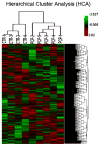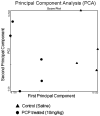Changes in gene expression after phencyclidine administration in developing rats: a potential animal model for schizophrenia
- PMID: 20691775
- PMCID: PMC5739316
- DOI: 10.1016/j.ijdevneu.2010.07.234
Changes in gene expression after phencyclidine administration in developing rats: a potential animal model for schizophrenia
Abstract
Repeated administration of phencyclidine (PCP), an N-methyl-d-aspartate (NMDA) receptor antagonist, during development, may result in neuronal damage that leads to behavioral deficits in adulthood. The present study examined the potential neurotoxic effects of PCP exposure (10mg/kg) in rats on postnatal days (PNDs) 7, 9 and 11 and the possible underlying mechanism(s) for neurotoxicity. Brain tissue was harvested for RNA extraction and morphological assessments. RNA was collected from the frontal cortex for DNA microarray analysis and quantitative RT-PCR. Gene expression profiling was determined using Illumina Rat Ref-12 Expression BeadChips containing 22,226 probes. Based on criteria of a fold-change greater than 1.4 and a P-value less than 0.05, 19 genes including NMDAR1 (N-methyl-d-aspartate receptor) and four pro-apoptotic genes were up-regulated, and 25 genes including four anti-apoptotic genes were down-regulated, in the PCP-treated group. In addition, the schizophrenia-relevant genes, Bdnf (Brain-derived neurotrophic factor) and Bhlhb2 (basic helix-loop-helix domain containing, class B, 2), were significantly different between the PCP and the control groups. Quantitative RT-PCR confirmed the microarray results. Elevated neuronal cell death was further confirmed using Fluoro-Jade C staining. These findings support the hypothesis that neurodegeneration caused by PCP occurs, at least in part, through the up-regulation of NMDA receptors, which makes neurons possessing these receptors more vulnerable to endogenous glutamate. The changes in schizophrenia-relevant genes after repeated PCP exposure during development may provide important information concerning the validation of an animal model for this disorder.
Published by Elsevier Ltd.
Figures




Similar articles
-
Long-term behavioral and neurodegenerative effects of perinatal phencyclidine administration: implications for schizophrenia.Neuroscience. 2001;107(4):535-50. doi: 10.1016/s0306-4522(01)00384-0. Neuroscience. 2001. PMID: 11720778
-
Schizophrenia-like GABAergic gene expression deficits in cerebellar Golgi cells from rats chronically exposed to low-dose phencyclidine.Neurochem Int. 2009 Dec;55(8):775-82. doi: 10.1016/j.neuint.2009.07.010. Epub 2009 Aug 3. Neurochem Int. 2009. PMID: 19651169 Free PMC article.
-
Prenatal exposure to an NMDA receptor antagonist, MK-801 reduces density of parvalbumin-immunoreactive GABAergic neurons in the medial prefrontal cortex and enhances phencyclidine-induced hyperlocomotion but not behavioral sensitization to methamphetamine in postpubertal rats.Psychopharmacology (Berl). 2007 Jun;192(3):303-16. doi: 10.1007/s00213-007-0729-8. Epub 2007 Mar 6. Psychopharmacology (Berl). 2007. PMID: 17340116
-
The neuropsychopharmacology of phencyclidine: from NMDA receptor hypofunction to the dopamine hypothesis of schizophrenia.Neuropsychopharmacology. 1999 Mar;20(3):201-25. doi: 10.1016/S0893-133X(98)00060-8. Neuropsychopharmacology. 1999. PMID: 10063482 Review.
-
Phencyclidine animal models of schizophrenia: approaches from abnormality of glutamatergic neurotransmission and neurodevelopment.Neurochem Int. 2007 Jul-Sep;51(2-4):173-84. doi: 10.1016/j.neuint.2007.06.019. Epub 2007 Jun 27. Neurochem Int. 2007. PMID: 17669558 Review.
Cited by
-
Perinatal administration of phencyclidine alters expression of Lingo-1 signaling pathway proteins in the prefrontal cortex of juvenile and adult rats.Neuronal Signal. 2018 Sep 28;2(3):NS20180059. doi: 10.1042/NS20180059. eCollection 2018 Sep. Neuronal Signal. 2018. PMID: 32714588 Free PMC article.
-
Neonatal phencyclidine administration and post-weaning social isolation as a dual-hit model of 'schizophrenia-like' behaviour in the rat.Psychopharmacology (Berl). 2014 Jun;231(12):2533-45. doi: 10.1007/s00213-013-3424-y. Epub 2014 Jan 9. Psychopharmacology (Berl). 2014. PMID: 24402141
-
Inhalation Anesthesia-Induced Neuronal Damage and Gene Expression Changes in Developing Rat Brain.Syst Pharmacol. 2013;1:1-9. doi: 10.2478/sph-2012-0001. Epub 2013 Jan 1. Syst Pharmacol. 2013. PMID: 29309069 Free PMC article.
-
Potential Adverse Effects of Prolonged Sevoflurane Exposure on Developing Monkey Brain: From Abnormal Lipid Metabolism to Neuronal Damage.Toxicol Sci. 2015 Oct;147(2):562-72. doi: 10.1093/toxsci/kfv150. Epub 2015 Jul 23. Toxicol Sci. 2015. PMID: 26206149 Free PMC article.
-
Molecular Mechanisms of Anesthetic Neurotoxicity: A Review of the Current Literature.J Neurosurg Anesthesiol. 2016 Oct;28(4):361-372. doi: 10.1097/ANA.0000000000000348. J Neurosurg Anesthesiol. 2016. PMID: 27564556 Free PMC article. Review.
References
-
- Ashe PC, Chlan-Fourney J, Juorio AV, Li XM. Brain-derived neurotrophic factor (BDNF) mRNA in rats with neonatal ibotenic acid lesions of the ventral hippocampus. Brain Res. 2002;956(1):126–135. - PubMed
-
- Baldridge EB, Bessen HA. Phencyclidine. Emerg Med Clin North Am. 1990;8(3):541–550. - PubMed
-
- Barbera JP, Rodriguez TA, Greene ND, Weninger WJ, Simeone A, Copp AJ, Beddington RS, Dunwoodie S. Folic acid prevents exencephaly in Cited2 deficient mice. Hum Mol Genet. 2002;11(3):283–293. - PubMed
-
- Benes FM, McSparren J, Bird ED, SanGiovanni JP, Vincent SL. Deficits in small interneurons in prefrontal and cingulate cortices of schizophrenic and schizoaffective patients. Arch Gen Psychiatry. 1991;48(11):996–1001. - PubMed
-
- Braff DL, Grillon C, Geyer MA. Gating and habituation of the startle reflex in schizophrenic patients. Arch Gen Psychiatry. 1992;49(3):206–215. - PubMed
MeSH terms
Substances
Grants and funding
LinkOut - more resources
Full Text Sources
Medical

